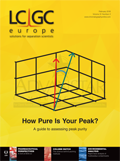Analytica 2018
Analytica will take place at the Messe München, Munich, Germany from 10–13 April 2018, alongside the Analytica conference that will take place at the International Congress Center (ICM) from 10–12 April 2018.
Photo Credit: S-F/shutterstock.com

Analytica will take place at the Messe München, Munich, Germany from 10–13 April 2018, alongside the Analytica conference that will take place at the International Congress Center (ICM) from 10–12 April 2018.
From clinical mass spectrometry to novel pollutants in foodstuffs to process analytics, the Analytica conference builds a bridge from research to applications using modern chemical and bioanalytical technologies. This year, the increasing automation and digitization of analytics is the common leitmotif of all conference days: What does having to process thousands and more samples every hour mean for laboratory management? Can the resulting data flood be reliably evaluated and managed at all? These and many other questions will be discussed at the Analytica conference by renowned scientists from all over the world.
The Analytica conference invites you to think outside the box and allow yourself to be inspired by colleagues from other analytical disciplines, according to the organizers. So why not visit the archeometry symposium, which provides information on measurement technologies in answering archaeological and historical questions.
The Analytica conference will take place at the congress centre in the immediate vicinity of the exhibition halls and is free of charge for all visitors to Analytica.
The full programme and abstracts of the lectures are available at: www.analytica.de/conference

A Matrix-Matched Semiquantification Method for PFAS in AFFF-Contaminated Soil
Published: April 14th 2025 | Updated: April 14th 2025Catharina Capitain and Melanie Schüßler from the Faculty of Geosciences at the University of Tübingen, Tübingen, Germany describe a novel approach using matrix-matched semiquantification to investigate per- and polyfluoroalkyl substances (PFAS) in contaminated soil.
Silvia Radenkovic on Building Connections in the Scientific Community
April 11th 2025In the second part of our conversation with Silvia Radenkovic, she shares insights into her involvement in scientific organizations and offers advice for young scientists looking to engage more in scientific organizations.











